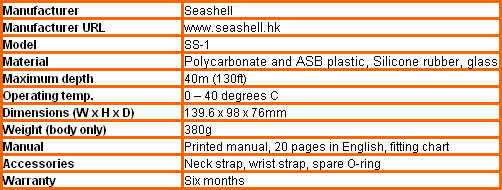Seashell SS-1 Waterproof Camera Case Review
Seashell SS-1 Waterproof Camera Case
Take your compact for a dip with this adaptable underwater case
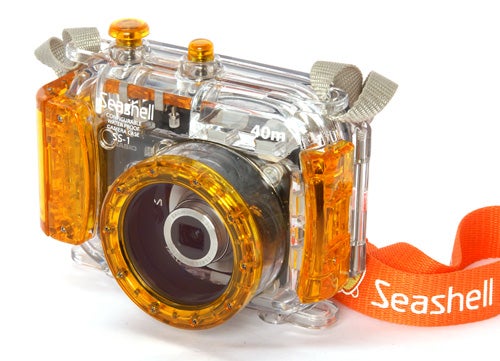
Verdict
Key Specifications
- Review Price: £149.99
I’ve looked at a few waterproof digital cameras recently, such as the Olympus mju-Tough 6020 or the stylish Sony TX5. These sort of cameras are fine for water sports or a dip in the sea, but they are only waterproof to a depth of a few metres. SCUBA diving has become a popular holiday activity, with diving schools and organised trips at many resorts in the clear waters of the Mediterranean or Caribbean. Even novice divers will usually dive to depths beyond the capabilities of these waterproof compacts, so if you want to take photos at diving depths you’re going to need something a bit more robust.
Many camera manufacturers produce custom underwater housings for their more popular models, and there are several third-party manufacturers that also make bespoke housings for a range of popular compacts, however these are often very expensive (usually around £200-£250), and if your compact camera doesn’t happen to be one for which a case exists then you’re out of luck. Or at least, you were.
Now there’s an alternative in the shape of the Seashell SS-1, a unique configurable underwater case that will fit most front-lens compact and ultra-compact digital cameras, and is waterproof to a depth of 40 metres. There is also another model, the SS-2, which will fit most compact cameras with corner-mounted internal lenses. It’s easy and fun to use, and costs less than £150, a lot cheaper than most custom cases.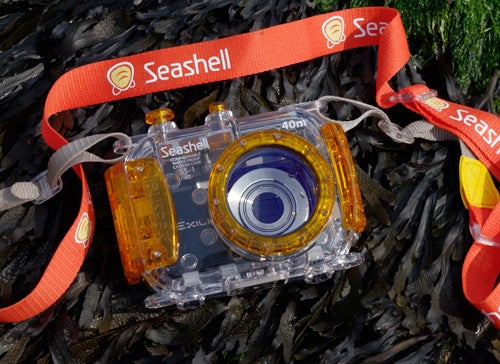
Like most underwater cases the Seashell is made from thick heavy-duty moulded transparent plastic, with a glass window on the front for the camera to look out of. Most of the case is clear, but it does have coloured trim areas and buttons, available in red, blue, purple or the orange shown here.
It is a two-part clamshell construction with a strong metal-pivoted hinge and a spring-loaded pressure clasp with a sliding lock. It has a durable O-ring seal around the edge of the rear panel, and sealed buttons on the top. It comes with a brightly coloured neck strap and wrist strap, and has a metal tripod bush on the bottom of the case which can be used to attach accessories such as lighting systems. The build quality is excellent, as you might expect from a protective housing, and the design is about as attractive as a big perspex box is going to get.
The SS-1 will fit any front-lens digital compact with dimensions not exceeding 101mm x 65mm x 29mm, and which has an on/off button the the shutter button on the top panel. This includes around 70 percent of all compact cameras, and certainly the vast majority of recent compact and ultra-compact cameras up to about 5x zoom, although some models with very long zoom lenses may not fit, and Panasonics with slider switches are not suitable.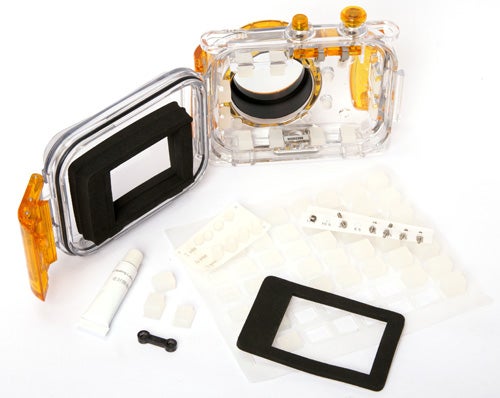
The secret to the SS-1’s adaptability is a system of silicone rubber cushions which slot into positions on the inside of the case. It comes with a sheet of rectangular cushions ranging from 1mm to 10mm in height that fit in around the sides, top and bottom , as well as smaller round cushions that support the front of the camera, and a selection of self-adhesive foam cushions that support the back of the camera with a cut-out to allow the monitor to be viewed.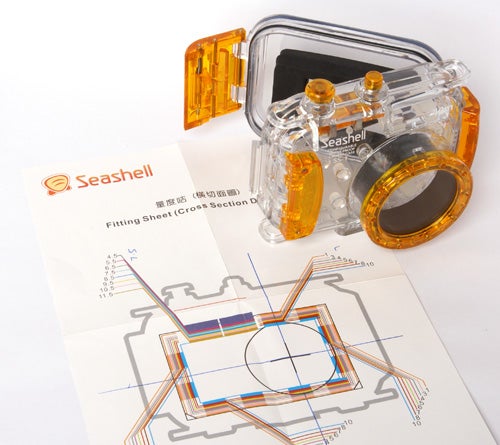
The rubber pads are re-usable, so that the case can be adapted to more than one camera, but the foam pads on the rear panel are pretty much impossible to remove without tearing them. However it does come with several of these pads, so if you change your camera you don’t have to buy a new case. Even if you run out of the proper pads it would be fairly easy to improvise with some foam off-cuts and double-sided sticky tape.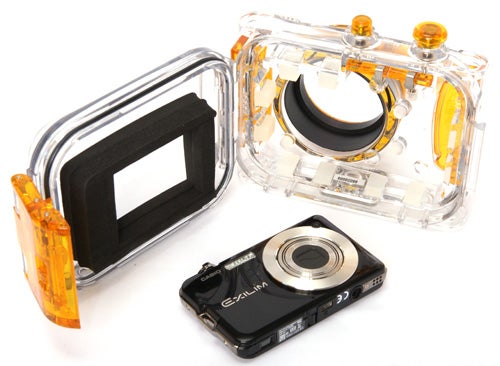
The case comes with easy-to-follow instructions and a handy measuring diagram to help you select the correct set of cushions for your particular camera. The only tricky part of the installation is adjusting the positions of the two button linkages to activate the on/off button and the shutter button. These have a selection of different length actuator rods that have to be screwed into place and then carefully positioned using a tiny and quite fiddly spanner, which is supplied. However with a bit of trial and error this too didn’t prove too difficult. The button linkages are quite loose, so cameras with very small controls may been a bit of persuasion to operate properly, but I was able to customise the case to fit my Casio EX-S12 ultra-compact in about 20 minutes.
The SS-1 case does have a couple of limitations. It has only two buttons, so the only camera controls you can operate while using the case are the on/off button and the shutter. You’ll need to set your camera on full automatic and select any underwater scene mode it may have before putting it in the case. Custom-made underwater cases usually have multiple buttons to allow almost full camera operation while underwater, but this would be impractical given the universal nature of the SS-1, and also immensely fiddly to set up.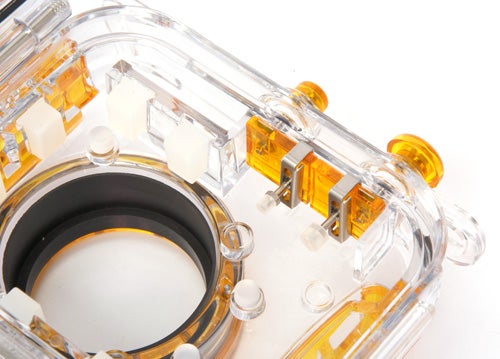
Another limitation is that for the majority of cameras it will not be possible to use a built-in flash, so this will have to be switched off. Again, many custom-made dive cases include prism systems and diffusers to allow underwater flash photography using the camera’s built-in flash, but with the SS-1 using the flash on the Casio EX-S12 just caused internal reflections that ruined the picture. This isn’t actually as much of a problem as it might sound, because using a camera-mounted flashgun underwater usually just results in a lot of back-scatter from suspended particles in the water. It’s a much better idea to use a high ISO setting or a longer shutter speed, especially since camera shake is less of a problem when vibrations are damped by the surrounding water.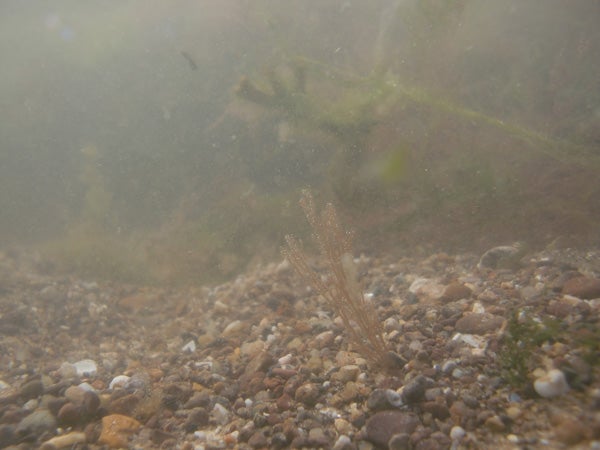
In actual use the SS-1 works extremely well. I’m not trained in SCUBA diving, but I took it snorkelling in the sea off the Devon coast and found it very easy to use. With the tiny and very light Casio EX-S12 inside the case was buoyant enough to float, but I suspect it would be possible to achieve neutral buoyancy by adding a couple of shot bags. As for picture results, obviously that will depend on the camera that you put inside it, and also the clarity of the water. The sea around Britain is notoriously cloudy, so I was only able to take a few fairly close-range shots, but the S12 has an underwater scene mode which produced good results.
”’Verdict”’
The Seashell SS-1 (and its stablemate the SS-2) provides a simple but brilliant solution for underwater photography using your everyday compact camera, and costs considerably less than a custom-made dive case. It is extremely well made, cleverly designed and reasonably easy to fit to almost any camera. It has some limitations, but overall it works like a charm.
